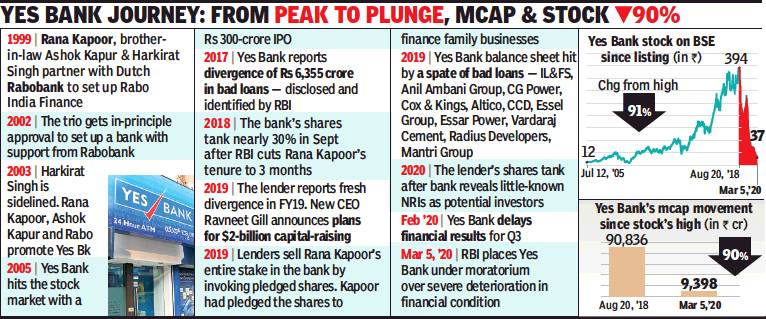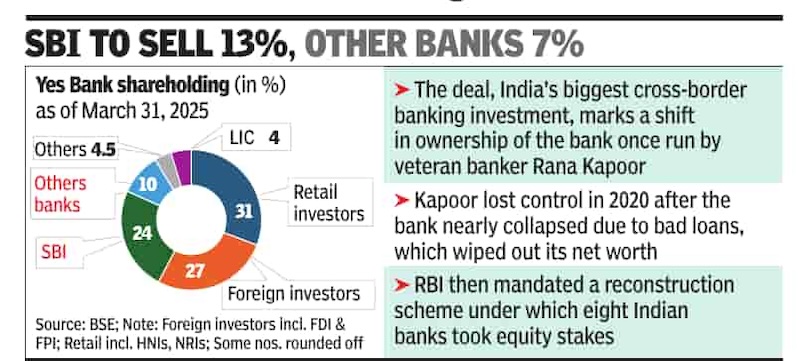Yes Bank
This is a collection of articles archived for the excellence of their content. |
Contents |
History
1993-2020
March 6, 2020: The Times of India

From: March 6, 2020: The Times of India
The word about Yes Bank in finance circles was that it was a lender which never said no to risky borrowers who had built a highly leveraged position. Veteran banker Rana Kapoor used his networking ability to lend and recover loans, distinguishing the bank from others which depended more on process rather than relationships.
When the business cycle turned and the central bank became tough on bad loans, Yes Bank ended up with a disproportionately high level of non-performing assets (NPAs) with a presence in almost every stressed account — whether it was DHFL, IL&FS, the Anil Ambani Group, Essel Group and many other troubled borrowers.
Kapoor was ousted by the Reserve Band of India (RBI) last year and his shares in the bank, which he once described as never-to-be-sold “diamonds”, were offloaded by lenders who had them under pledge. His successor Ravneet Gill has been struggling for a year to keep afloat the bank that Kapoor built, but ran out of time with the RBI pulling the plug on Thursday. Kapoor, who started his career as an intern with Citibank New York, joined Bank of America in 1980 and led its wholesale banking business in Asia. He headed ANZ Grindlays’s investment bank, then the largest in India, up to its acquisition by StanChart in 1998.
It was at this point that Kapoor began the pursuit of his dream to set up his own financial institution by floating Rabo India Finance with brotherin-law Ashok Kapur and another banker Harkirat Singh.
In 2003, Kapoor and Kapur floated Yes Bank — the second time that the RBI was experimenting with granting a banking licence to professionals. The time was fortunate, as a year later another professional-promoted institution — Ramesh Gelli’s Global Trust Bank — folded up.
Rising profits boosted the share price with Kapoor’s holding turning him into a billionaire. A large part of the bank’s profits came from the upfront fees that it earned on risky term loans. Many bankers feel that Kapoor would have been better off had he agreed to sell his stake to new promoters and exited from Yes Bank in 2017.
However, despite being ousted by the central bank, Kapoor fought back and swore never to sell his shares.
As luck would have it, Yes Bank’s woes worsened with a series of unexpected defaults hitting it in quick succession, beginning with IL&FS and DHFL. While his successor Gill tried his best to bring in new investors, the spate of defaults and their slow resolution in the bankruptcy courts turned investors sceptical. Ultimately, the RBI had no choice but to use its ultimate weapon of placing the bank under moratorium.
Even after launching the bank, Kapoor had three major setbacks. First, his brother-in-law and co-promoter Kapur was killed at the Taj hotel in Mumbai during the 26/11 terror attacks. Soon thereafter, the global financial crisis broke out and there was a credit squeeze, with Yes Bank being badly hit because of its dependency on wholesale loans.
However, the subsequent easing by the central bank and government support helped the bank get back on its feet almost immediately. The third was a boardroom battle with Madhu Kapur, his sister-inlaw. While this ended in a truce, Kapoor did not have the satisfaction of having his own people on the board.
When the going was good, Kapoor used his stake to raise around Rs 630 crore by pledging his shareholding in the bank through two promoter entities — Morgan Credit and Yes Capital.
However, as the share price of his bank collapsed, lenders began selling all his holding, pushing down the share price even further, and thereby hurting the revival plans of the bank as well.
2018
Major changes at the top
Yes Bank has said that its board will meet on December 13 to appoint a new chairman and directors. On Tuesday, the private bank’s shares crashed over 6% after the exit of nonexecutive independent director Rentala Chandrashekhar.
While Chandrashekar’s exit was announced on Monday citing personal reasons, on Tuesday the bank issued a revised statement dropping out any reference to the reason behind his leaving. This led to speculation that his exit from the board was not entirely voluntary.
Rana Kapoor, the bank’s founder and CEO, said that efforts are underway for mutual resolution with Madhu Kapur and family, the co-promoter of the bank. “This is intended to ensure better support and coordination by the two promoter groups with the board of directors of the bank,” a statement from the bank said.
On November 14, the bank’s non-executive chairman Ashok Chawla had resigned as his name figured in a CBI chargesheet filed in the Aircel-Maxis case. Another independent director Vasant Gujarathi, too, had tendered his resignation on the same day.
2025
Sumitomo Mitsui Banking Corporation to acquire 20% stake
Mayur Shetty, May 10, 2025: The Times of India

From: Mayur Shetty, May 10, 2025: The Times of India
Mumbai: Five years after a group of Indian lenders led by SBI stepped in to rescue Yes Bank, Japan’s Sumitomo Mitsui Banking Corporation (SMBC) will acquire a 20% stake in the private lender for Rs 13,483 crore, making it the largest shareholder. The deal, India’s biggest cross-border banking investment, marks a shift in ownership of the bank once run by veteran banker Rana Kapoor.
Kapoor lost control in 2020 after the bank nearly collapsed due to bad loans, which wiped out its net worth. RBI then mandated a reconstruction scheme under which eight Indian banks took equity stakes.
SBI will now sell a 13.2% stake, cutting its holding to just over 10%. ICICI Bank, HDFC Bank, Kotak Mahindra Bank, Axis Bank, IDFC First Bank, Federal Bank, and Bandhan Bank will offload a combined 6.8%. The deal is priced at Rs 21.5 per share, above the recent market price and more than double what the rescuing banks invested.
SMBC, a unit of Japan’s secondlargest bank by assets, will become Yes Bank’s anchor investor after securing regulatory and shareholder approvals. The deal may reshape the bank’s strategy and comes amid SMBC’s broader push into Asia. Its parent, Sumitomo Mitsui Financial Group, has $2 trillion in assets and recently took full ownership of its Indian NBFC arm, SMFG India Credit (formerly Fullerton).
SMFG sees India as a counterweight to Japan’s ageing population and low growth. The firm is betting on India’s demographics and macroeconomic momentum.
On May 6, after reports of SMBC’s interest, Yes Bank denied knowledge of any unannounced developments, causing shares to erase a 10% gain. The stock again surged 10% on Friday ahead of the announcement. Banking industry observers are waiting to see if SMBC takes the wholly-owned subsidiary (WoS) route in Yes Bank. In the past, both DBS and State Bank of Mauritius used the WoS route to acquire a local banking licence. Most large foreign banks operate as branches and need permission to open new ones. SMBC will also have to deal with a bank that has a bloated equity base, following massive capital infusions.